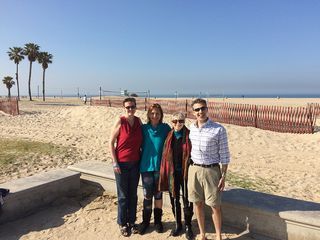Rachel Barenblat's Blog, page 106
May 2, 2016
That's why
Because I could say your names
tasting them on my tongue
for hours and not grow tired.
Because when you're with me
I sparkle like water in the sun.
Because I turn toward your light.
Because when I remember you
I shine like Moshe come down
from the mountain.
Because my heart, full of you,
bursts open like a ripe fig
juicy and sweet.
Because I could say your names... for hours. Both the Jewish mystical tradition and Sufi mystical tradition contain the devotional practice of reciting names of God. Because I turn toward your light. Reb Zalman z"l taught that just as plants are phototropic, and naturally turn toward the source of light which nourishes them, human beings are theo-tropic and naturally turn toward God. I shine like Moshe come down / from the mountain. Torah teaches that when Moses came down from Mount Sinai, having communed with God and received the Torah, his face was so radiant that he had to wear a veil to protect the people around him from his light.
This is another of the poems in my Texts to the Holy series.

May 1, 2016
Come write midrash with me at the ALEPH Kallah!
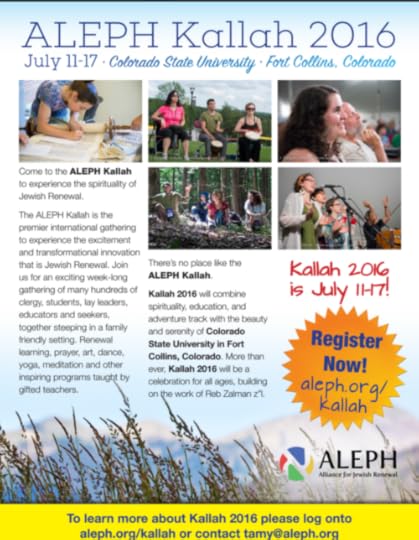
Hey, want to spend a week writing contemporary midrash with me in beautiful Colorado this summer?
There are just a few spots left in the class I'm teaching at the ALEPH Kallah this year. For those who are interested, here's the description of what I'll be offering:
TURN IT AND TURN IT (THE MIDRASHIC PROCESS)
Midrash are interpretive stories (the name comes from the Hebrew לדרוש, to interpret). Midrash speak in a multiplicity of voices as they open new facets of Torah... and diving deep into Torah is one of the most perennial “Joys of Jewishing!” In this class we’ll begin by exploring classical midrash to examine how they work, then we’ll delve into contemporary midrash (in a variety of forms: poetry, music, film), then learn the midrashic process from the inside out as we write our own midrashic texts, embroidering our voices onto the ongoing tapestry of interpretation.
If writing your own midrash sounds like fun, I hope you'll join me. Enrollment in my class is limited, so sign up now!
And, of course, there are many other amazing offerings -- if my class isn't your cup of tea, check out the Kallah 2016 Class and Workshop Guide. I highly recommend clicking on the interactive pdf file and reading through the whole catalogue.
There's no better way to experience the joy, vibrancy, and "juice" of Jewish Renewal than to come to the ALEPH Kallah. The things I love most about Kallah include the creative and varied davenen (prayer), the sense of community, and the learning. I hope you'll join us -- whether or not you're inclined to sign up for my class -- and (re)discover for yourself what about Kallah you love most.
I've posted a fair amount over the years about different experiences with the ALEPH Kallah; if you're so inclined, you can read those old posts via my ALEPH Kallah tag.

April 29, 2016
Seder for the seventh day: a celebration of taking the leap
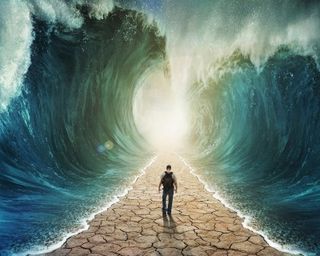 It was on the seventh day after the Exodus that our forebears made it to the shore of the Sea of Reeds. Behind them, the Egyptian army. Ahead of them, the sea. (At least, so teaches our tradition.)
It was on the seventh day after the Exodus that our forebears made it to the shore of the Sea of Reeds. Behind them, the Egyptian army. Ahead of them, the sea. (At least, so teaches our tradition.)
Midrash teaches that not until a man named Nachshon ben Aminadav walked in up to his neck did the waters part. The seventh day of Pesach is the anniversary of that leap of faith.
The custom of holding a seder on the first night or two of Passover is one of the practices most widely observed across the Jewish world. (In the Pew study that came out a few years ago, seven in ten Jews reported participating in Passover seders.)
The custom of holding a seder on the seventh day is less well-known, and less formalized -- and as a result, there's more room for ritual and liturgical creativity. This year's seventh-day seder (unlike last year's) took place without a haggadah. We had no foreordained plan for the journey. Instead we traveled with our mental map of the steps of seder, from sanctification to conclusion, and explored the internal territory revealed to us along the way.
The only ritual items we had on hand were wine to bless, and matzah: the bread of affliction and of freedom all in one. We gave matzah yet another meaning, declaring it to be the bread of choosing. One can always remain in familiar constriction, instead of taking the risk of stepping into the unknown. But authentic spiritual life calls us to choose becoming, instead. It calls us to take the leap into the sea.
We began Maggid, the storytelling step of the seder, by asking Four Questions of our own. We took turns contributing questions and answers, without preparation. Perhaps it wasn't coincidence that the questions that came to us in that ritual moment were big questions that don't have simple answers. That's the valance of this moment in the year: crossing the sea, not knowing what's on the other side.
We told the story of our people through the prism of our own story: from who we were then to who we are now; from times of constriction to times of liberation, not once but again and again. We remembered davening at the edge of an ocean not so long ago, and we imagined ourselves standing at the edge of the sea, taking the leap of trusting that the waters would divide and let us safely through.
Like last year, we made meaning in the items that were within reach. We turned my can of Fresca (with the aid of some gematria, a.k.a. Hebrew letter-math) into a parable about God lifting us away from Pharaoh, and turned a small rainbow slinky into the coiled spring which helps us leap from slavery into freedom. We laughed, but the meaning we found (or made) in what was at hand felt true and real.
Many of us spend the month before Pesach preparing diligently for the first two seders. The seventh day seder is different. It felt good to me this year to approach the seventh day seder in a spirit of openness. The seventh day is when we take a deep breath and walk boldly into the waters, not knowing for certain that they will part. No amount of advance preparation can truly ready us for taking that leap.
There's something extra-sweet about doing something free-form in between ritual experiences that are more fixed and more liturgical -- like the sedarim that Rabbi David and I led last weekend, and the services we'll lead this Shabbat. Perhaps if we're lucky we'll be able to take into our services a bit of our seventh-day-seder whimsy, a bit of the Not Knowing that can fuel our awe and our joy.

April 28, 2016
Doctor Who to the rescue
 I was interviewed recently by Michael A. Burstein for the Jewish Advocate, for an article about Doctor Who, role-playing, and summer camp.
I was interviewed recently by Michael A. Burstein for the Jewish Advocate, for an article about Doctor Who, role-playing, and summer camp.
Speaking about the study, Rabbi Barenblat noted, “I love the idea of using Doctor Who to help kids battle depression. Connecting with fictional characters can help kids feel less alone, and he’s a wonderful character, resilient and kind. Anyone can benefit from identifying with a heroic archetype, and the Doctor -- like the Biblical archetypes we meet in Tanakh -- is both wonderful and flawed... which makes him, like the Biblical figures, relatable and (although he is a Time Lord) very ‘human.’ “
Read the whole thing here: 'Dr. Who' to the rescue. Thanks for including me, Michael!

April 24, 2016
Article in the Vancouver Independent
Thanks to the Vancouver Jewish Independent for the lovely article about our recent visit to Vancouver as part of the ALEPH / Jewish Renewal Listening Tour! (Though they magically transformed me from a Barenblat into a Rosenblatt.) Here's a taste:
“Every stop on the ALEPH: Jewish Renewal Listening Tour is different, and every one has been amazing in its own way. But I suspect that our weekend in Vancouver may stand out in memory as one of the most memorable experiences in a year-plus of remarkable experiences,” wrote Rabbi Rachel Rosenblatt on her blog, the Velveteen Rabbi...
“When ALEPH decided to go on a listening tour, it initially was to take the pulse of the Jewish Renewal movement, but it has come to mean for us and for stakeholders in the broader renewing of Jewish life so much more than that,” said Markus. “There is a yearning in Jewish life today that reaches through all the denominations … we are seeing a global consciousness arise about the need to reconnect Jews with the heart and soul of tradition, to experience the riches of spiritual life, and to address emerging social and ecological challenges.”
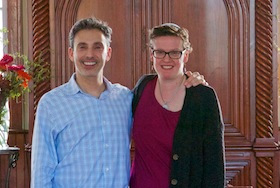
Rabbis David Evan Markus and Rachel Barenblat, co-chairs of ALEPH: Alliance for Jewish Renewal. (photo by David Kauffman)
Markus explained that Jewish Renewal has grown organically, and was not created on the basis of strategy or design. “The time has come,” he said, “to introduce an element of design.” How should the Renewal movement take its rightful place in ecosystem of Jewish life? What does Jewish life need now? How to meet the needs of millennials? Summing up, Markus said, “How are we relevant for the 21st century and beyond?”
Read the whole thing: Or Shalom Hosts ALEPH Tour.

April 20, 2016
And the day came...
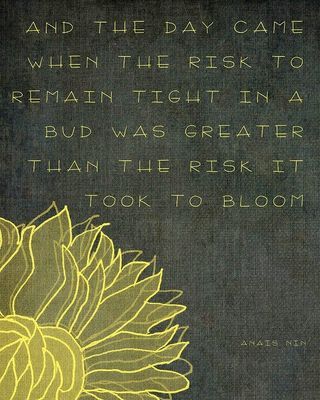 I've been sitting with this Anaïs Nin quote for a while. "And the day came when the risk to remain tight in a bud was greater than the risk it took to bloom." It feels especially resonant to me as Pesach draws near. The Pesach story is one of risk-taking.
I've been sitting with this Anaïs Nin quote for a while. "And the day came when the risk to remain tight in a bud was greater than the risk it took to bloom." It feels especially resonant to me as Pesach draws near. The Pesach story is one of risk-taking.
The Pesach story says: in every life there are familiar constrictions. Sometimes we suffer them. Sometimes we accept them grudgingly. Sometimes we embrace them. Sometimes we grow so accustomed to them that we forget they're there.
And in every life there are awakenings. We realize that we don't need to stay where we are. We realize that we could choose to risk the unknown, even though it's scary, even though we don't know what lies ahead. The Pesach story says: take the leap. Step into the sea and trust that it will part for you.
The Pesach story says, if we wait until we feel fully ready we might never act at all. The Pesach story says, we can stay where we are indefinitely, but at what cost to our hearts and our souls? We are made to change and grow, and sometimes that means setting out into the wilderness of not-knowing. Sometimes that means taking the risk of trusting that good things lie ahead, even if we can't see them from here. Sometimes it means leaping before we feel ready, because the whole idea of "ready" becomes something that's holding us back.
Can you imagine what it's like to be a tulip curled into a bulb, waiting patiently through the long and perhaps snow-covered winter for the indescribable call to unfold, to stretch toward the light, to shatter and expand and become something glorious and new? The Pesach story is like that. It's the beginning of our unfolding into the nation we continue to become. As a people we were curled into a tight place until we were brought forth from there -- maybe by the same ineffable force that whispers to tulip bulbs when it's time to burst free and emerge from underground.
Tradition teaches that each of us must relate to the Pesach story as though it had happened not then to them but also to us. The movement from constriction to freedom is recapitulated in every life, in the trajectory of every soul. But it's not just an individual story; the Pesach story is also a collective one. After the Exodus our mixed multitude became a people. We went forth together, and together we grew into something new, something greater than the sum of its parts. We went from being slaves of Pharaoh to being servants of the One. This is the core story of Jewish peoplehood.
The Pesach story doesn't offer easy answers. Torah reminds us that once the children of Israel leave Egypt they kvetch bitterly, missing the familiar comforts of the life they used to know even though that life contained grief and silencing and hard labor. That's human nature. It's hard to leave what we've known, even if we believe that God is bringing us forth from where we've been in order that we might be made new. In order that we might serve from that place of having been made new. Each of us has to choose, time and again, to become. To be open to changing. To learn to bloom.
Blooming is a risk. There could be a late frost, or not enough rain, or not enough sun. Anything could go wrong! There are always reasons not to bloom, or not to bloom yet. Pesach comes to call us out of those reasons. The One Who spoke to Moshe from the burning bush claimed the name "I Am Becoming What I Am Becoming." Our God is always becoming, and so are we. The day comes when the risk of remaining tight in a bud is greater than the risk of choosing to follow God's example and become. Maybe this is that day. What would you need in order to trust that this can be that day for you?
Chag sameach -- wishing a deep and sweet and meaningful Pesach to all who celebrate.

April 19, 2016
An ALEPH Listening Tour week in California
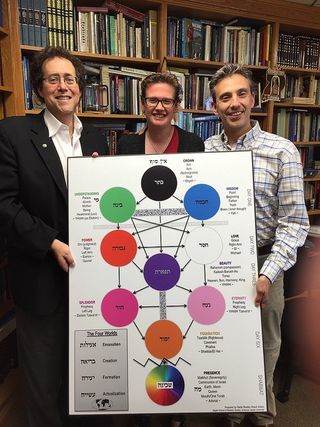 How can I begin to write about the sum total of ten days of ALEPH / Jewish Renewal Listening Tour travel? This is our twelfth of thirteen trips over the course of a year. The others were weekends or conferences: deep and intense, but relatively brief. This one lasted for more than a week, and the level of depth and intensity did not falter.
How can I begin to write about the sum total of ten days of ALEPH / Jewish Renewal Listening Tour travel? This is our twelfth of thirteen trips over the course of a year. The others were weekends or conferences: deep and intense, but relatively brief. This one lasted for more than a week, and the level of depth and intensity did not falter.
I began in Las Vegas at a P'nai Tikvah Shabbaton for which I was the visiting scholar. Rabbi David began in San Diego at the Spiritual Directors International conference, connecting with spiritual directors both inside and outside of the Jewish Renewal community, and did a community Listening Tour open mike with Elijah Minyan and Shirat HaYam.
We met up in Los Angeles. We did a community open mike there, with a ma'arv service, hosted by Holistic Jew. We met with a focus group at the Ziegler School of Rabbinic Studies, and with Ziegler's dean Rabbi Bradley Shavit Artson. We met with Rabbi Mike Comins of Lev Learning. We met with a focus group from the Academy for Jewish Religion California and talked about interseminary collaboration. We davened on the beach.
We traveled north. We did a dinner and a community open mike at Chadeish Yameinu in Santa Cruz. We had a lunch and a focus group conversation with the Aquarian Minyan. We met up with Rabbi Noa Kushner from The Kitchen, and Jeff Kasowitz and Rabbi Adina Allen from The Jewish Studio Project. We met with a group of millennials and young leaders convened by Hazzan Shulamit Wise Fairman of Kehilla. We met with Rabbi Michael Lerner of Beyt Tikkun.
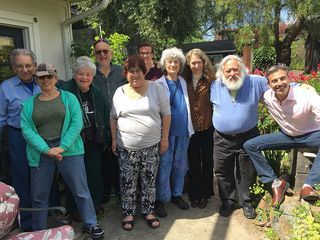 We co-led davenen at Holistic Jew in LA, and participated in leading davenen at Kehilla Community Synagogue. At Kehilla Rabbi David was the darshan -- teacher of Torah -- on Friday evening, and I was the darshanit on Saturday morning. We leyned from Torah on Shabbat morning before a beautiful community babynaming. We spent Shabbat afternoon holding a community open mike session.
We co-led davenen at Holistic Jew in LA, and participated in leading davenen at Kehilla Community Synagogue. At Kehilla Rabbi David was the darshan -- teacher of Torah -- on Friday evening, and I was the darshanit on Saturday morning. We leyned from Torah on Shabbat morning before a beautiful community babynaming. We spent Shabbat afternoon holding a community open mike session.
We dined with theKehilla Community Synagogue board and the Chochmat Ha-Lev board. We traveled from hither to yon across communities and neighborhoods in the Bay Area. We stopped often to marvel at California's palm trees, blooming roses, sea otters, and vistas where Pacific waves are rolling in to shore. We did a community open mike at Chochmat Ha-Lev, once a Jewish meditation center and now a congregational community of practice. We flew home.
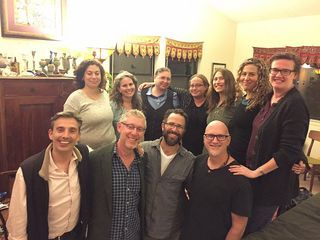 Those are the outlines of our itinerary, but they barely scratch the surface of the conversations, the deep sharing, the hopes and dreams articulated, the rebuilding of bridges, the new and renewed connections contained within our week-plus on the road.
Those are the outlines of our itinerary, but they barely scratch the surface of the conversations, the deep sharing, the hopes and dreams articulated, the rebuilding of bridges, the new and renewed connections contained within our week-plus on the road.
Everywhere we go, we hear some things that are unique to the place that we're visiting. No two communities have the same history, the same needs, the same story. And everywhere we go, we hear some things that resonate with things we've heard in other places we've been, which means that the harmonies of common notes are beginning to emerge. I'm beginning to get an idea of what it will be like to begin working on Renewing Renewal, the report that Rabbi David and I intend to offer before Rosh Hashanah. What will be the integration of this fifteen months of traveling, opening our hearts, and listening with all that we are?
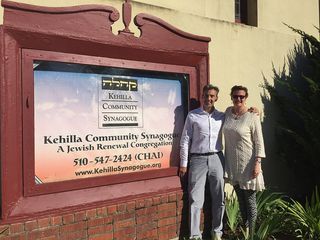 Right now I'm thinking about (what were for me) unexpected similarities between Vancouver and California, and about the West Coast and its general friendliness to innovation. I'm thinking about how deliciously different is the davenen at each of these Jewish Renewal communities -- and also about what makes the davenen feel similar in heart and spirit even when it takes different forms.
Right now I'm thinking about (what were for me) unexpected similarities between Vancouver and California, and about the West Coast and its general friendliness to innovation. I'm thinking about how deliciously different is the davenen at each of these Jewish Renewal communities -- and also about what makes the davenen feel similar in heart and spirit even when it takes different forms.
The Bay Area has a unique Jewish Renewal history, and I'm fascinated to see that some of the spectrum of differences spanned within ALEPH writ large is also spanned within the Jewish Renewal communities of the San Francisco Bay Area. I love this evidence of Jewish Renewal's multivocality.
We have one more Listening Tour trip to go: the Denver / Boulder area in late May. We have online focus groups scheduled with states and countries we couldn't manage to reach in person. We're always receiving emails in response to our big questions about what you hope the future of Jewish Renewal will be. And as we move into summer, the Listening Tour will reach its conclusion and we'll dive into synthesizing what we've heard -- though of course the holy work of listening will always be part of our service as co-chairs, even when the formal tour is complete.
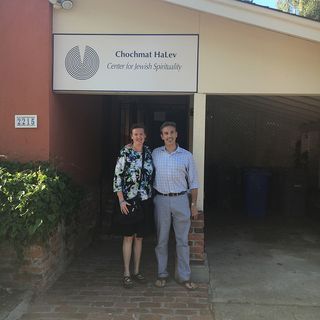 It's humbling to hear people's deepest yearnings for Judaism and for spiritual life. And it's awesome to have an opportunity to serve an organization that I think can bring those yearnings to fruition.
It's humbling to hear people's deepest yearnings for Judaism and for spiritual life. And it's awesome to have an opportunity to serve an organization that I think can bring those yearnings to fruition.
Special gratitude is due to Rabbi Diane Elliot of Embodying Spirit, Enspiriting Body and Rabbi David Cooper of Kehilla Community Synagogue for facilitating our connections with various branches of the Bay Area Jewish Renewal community.
Photos from top to bottom: us with dean Rabbi Bradley Shavit Artson from Ziegler; with an Aquarian Minyan focus group; with a focus group of young leaders convened by Kehilla Community Synagogue; at Chochmat Ha-Lev. These photos and many others are in my California Listening Tour flickr photoset.

April 13, 2016
Oceanside shacharit
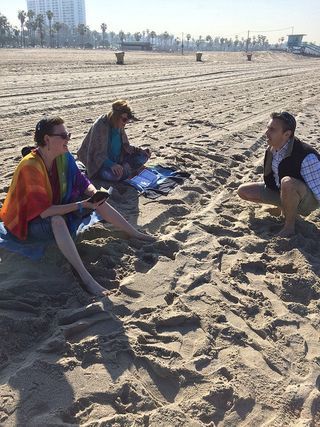 One of my dreams, for this week in California, was to manage to daven one morning on the beach. As it turns out, it's only about a block from the friend's house where I've been staying to the edge of the Pacific.
One of my dreams, for this week in California, was to manage to daven one morning on the beach. As it turns out, it's only about a block from the friend's house where I've been staying to the edge of the Pacific.
As we walk down to the beach, the sun is shining brightly in a sky of pale robin's-egg blue. As we draw closer to the water, the wind lifts up my featherweight rainbow tallit around me like wings.
We settle on the sand. Whoever feels moved offers the beginning of a prayer -- either a beloved melody, or the beloved lilt of weekday nusach -- and the rest of us join in. We work our way through the whole matbeah, the ancient ladder of the prayer service.
At the appropriate moment I chime in with part of the Song at the Sea, because -- well, here we are, at the seashore on the cusp of Pesach. Ozi v'zimrat Yah -- "My strength is in Your song..." Next time I sing those words at havdalah they will have a different feel.
Seagulls fly overhead. A sandpiper pecks at the wet sand by the water's edge. Two wetsuit-clad surfers paddle out into the water, and from time to time I see one of them stand and glide a ways in toward shore.
We move in and out of nusach. We have moments of silence which I spend beaming. We sing "Mi Chamocha" to the melody of "Adir Hu," a Pesach song, which evokes years of Passover memories. When we rise into our amidah, our standing prayer, I have a shivery moment of recognition. Recently I had a mental image of a doorframe on the beach at the edge of the sea. Suddenly the sea ahead of us here reminds me of the view through that door.
We close with "Eli, Eli," a setting of a poem by Hannah Szenes. In English, it can be rendered as "My God, my God, I pray that these things never end: the sand and the sea, the rush of the waters, the crash of the heavens, the prayer of the heart." As we walk away from the beach, the prayer of my heart is a fervent Thank You. Thank You. Thank You.
Four happy daveners, primed now for fabulous morning meetings!
(L to R: me, Rabbi T'mimah Ickovits of Holistic Jew, ALEPH's Rosh Hashpa'ah Rabbi Shohama Wiener and my co-chair Rabbi David Evan Markus.)
Many thanks to the kind stranger who graciously snapped our photo so we could all be in the picture.

April 10, 2016
Letting your light shine
וַיְדַבֵּר יי אֶל-מֹשֶׁה וְאֶל-אַהֲרֹן לֵאמֹר אָדָם, כִּי-יִהְיֶה בְעוֹר-בְּשָׂרוֹ...
"The Eternal spoke to Moses and Aaron saying: If a person has in the skin of the flesh a sore ..." (Leviticus 13:1-2).
Tazria is not my favorite Torah portion. There are no "bad" Torah portions -- there's good in all of them! -- but I can admit that this is one with which I have struggled over the years. Some years I struggle with the teachings about childbirth. This year I got bogged-down in the verses about this skin condition and its treatment. Fortunately, the Hasidic master known as the Sfat Emet -- Yehuda Leib Alter of Ger -- came to my rescue.
The Sfat Emet looks at the half-verse I cited above, and enters into it with a kind of Hebrew pun. He makes a link between the Hebrew words 'or (עור), meaning skin, and 'or (אור), meaning light. With this move, he radically transforms what Torah is talking about: suddenly this is no longer about an illness that generates sores in the skin, but a spiritual illness which does something to a person's inner light.
In Bereshit / Genesis, when the first humans are exiled from Eden, God makes them garments of skins. Our mystical tradition reads this creatively to suggest that we didn't have skins at all until we ate from the tree of the knowledge of good and evil -- before we ate from that tree we were garbed in pure light. At havdalah, when we hold up our hands to the flame, we see glimmers of light reflected in our fingernails -- maybe a reminder of the light in which we were once clothed, or maybe a reminder of the light in which we will be clothed in the world to come, since there's also a teaching from the Zohar that in the world to come we will wear garments woven out of the brightly shining mitzvot we performed in this life. (I've written about these ideas before.)
So: Torah is talking about a physical affliction in one's skin, but the Sfat Emet is (mis)reading it as being about an affliction which keeps one's light from shining.
I've been thinking a lot lately about skin as what covers us and keeps us safe from the world. Have you ever had times in your life when you've felt especially "thin-skinned," especially vulnerable to harsh words or difficult realities? Sometimes I've come away from a week on retreat feeling that the week of prayer and study and community and safety has made my skin feel too thin for the "regular" world. Often by the time I get through the intensive spiritual work of the Days of Awe, my skin feels thin and my heart feels close to the surface, even exposed.
Skin keeps us safe. But -- at least according to the Sfat Emet -- it shouldn't keep us from shining. You might remember that when Moshe came down from Sinai his face glowed, maybe because his inner light was able to shine through his phyical skin. It's as though his skin became transparent and everyone was able to see his true light. And it's worth remembering that his light was too much for the people, so he had to veil to protect them from the radiance he acquired as a result of his experience of God. Sometimes people don't want to see radiance. Maybe it scares them, or reminds them of how their own light has been kept from shining.
For the Sfat Emet, tzara'at represents a closing or clogging of our pores, which results in our light not being able to shine through. (It's noteworthy that the root of the word tzara'at suggests narrowness and constriction.) Tzara'at is a metaphor for what happens when we sin, when we miss the mark: we become clogged or closed-off and our light can't shine.
What kinds of things -- experiences, relationships, encounters -- make you radiant?
Can you feel it when your inner light is shining through? What does that feel like to you?
What gets in the way of your inner light shining?
When something is blocking the flow of that inner light, how do you cleanse yourself -- what can you do in any or all of the four worlds of body, emotion, thought, and spirit -- so that your light can shine again?
This is a teaching I gave over yesterday morning during Torah study at the P'nai Tikvah Shabbaton in Las Vegas where I was privileged to be scholar-in-residence for the weekend. Deep thanks to Rabbi Yocheved Mintz and the P'nai Tikvah community for inviting me.
(Image source.)

April 8, 2016
Jewish Renewal on Radio Centre-Ville
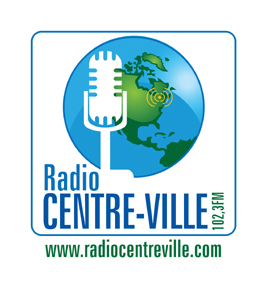 When we were in Montréal last month on the ALEPH / Jewish Renewal Listening Tour, Rabbi David and I -- along with Rabbi Jan Salzman, visiting from Burlington, and Rabbi Shalom Schachter, visiting from Toronto -- were interviewed by Leslie Lutsky for Radio Centre-Ville.
When we were in Montréal last month on the ALEPH / Jewish Renewal Listening Tour, Rabbi David and I -- along with Rabbi Jan Salzman, visiting from Burlington, and Rabbi Shalom Schachter, visiting from Toronto -- were interviewed by Leslie Lutsky for Radio Centre-Ville.
The interview will air on April 9th at 8:30 in the morning on 102.3FM and online at Radio Centre-Ville. It will also be available as a podcast for a week.
Here's a taste of what we had to say:
Jewish Renewal is the most recent expression of the yearning of the Jewish spirit. We understand Judaism and all spiritual life to evolve. We have been doing it for thousands of years, and we never imagine stopping. Jewish Renewal understands this , and evolves pathways of spirituality that are based in the ways of the earth, based in the collectivity of political, economic, social and spiritual expressions, understands that Jewish life has never been frozen in a time or place or one way of doing things or being…and so ALEPH, as the umbrella organization for Jewish Renewal, understands and seeks to achieve a world that is beyond denominational lines, that is beyond the fractures of one way of being spiritual or religious, and to work with others who are like-minded and like-hearted in bringing that kind of Jewish spirituality into the world. -- Rabbi David Markus
Jewish Renewal takes a variety of forms. It’s not one single thing everywhere you go. It’s characterized by heart, by spirit, by direct experience of connection with the holy and with God, by music, by creative liturgy, innovative approaches to liturgy and prayer, by a commitment to social justice and transformation of the world... [In] anything that identifies as Renewal, you will find most if not all of these things. -- Rabbi Rachel Barenblat
Deep thanks to Leslie for interviewing us, and for giving us the opportunity to share some of what's exciting to us about Jewish Renewal with the listeners of Radio Centre-Ville.

Rachel Barenblat's Blog
- Rachel Barenblat's profile
- 6 followers



